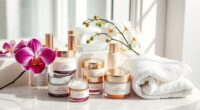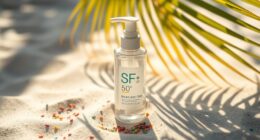To get the best results from your pimple patches, you should wear them for at least 6 to 8 hours. This gives them enough time to absorb excess oil and impurities, which promotes faster healing. If you’re dealing with stubborn breakouts, you can even leave them on for up to 24 hours. Just make sure to replace them if they become saturated. Want to know more tips on effective use and types of patches?
Key Takeaways
- For minor blemishes, wear pimple patches for about 4 hours for optimal results.
- The standard duration for most pimples is 6 to 8 hours.
- Stubborn breakouts can have patches worn for up to 24 hours.
- Replace patches if they become saturated or start peeling off.
- Adjust usage duration based on skin type and acne severity for best results.
Understanding Pimple Patch Mechanics

When you understand how pimple patches work, you can maximize their benefits for clearer skin.
Pimple patches are primarily made from hydrocolloid, a gel-forming material that absorbs excess oil and impurities from your pimples. Some patches include active ingredients like salicylic acid and tea tree oil, enhancing their effectiveness. Hydrocolloid patches are effective for blemishes that have come to a head, as they draw out fluid while creating a moist healing environment, reducing inflammation and protecting the skin from external irritants. Plus, they act as a barrier, preventing you from picking at your pimples, which helps lower scarring risks.
Many patches are designed to be discreet, allowing you to wear them confidently throughout the day or night.
Recommended Duration for Optimal Results

To achieve ideal results with pimple patches, it’s essential to follow the recommended wear times based on the severity of your blemishes.
For minor blemishes, wearing a patch for about 4 hours can be effective, as these patches absorb impurities quickly. It’s important to note that these patches are most effective on whiteheads, the final stage of a pimple’s life cycle.
However, for most pimples, aim for a standard duration of 6 to 8 hours. This allows the patch to absorb maximum fluid, indicated by a white or cloudy appearance.
For optimal results, wear pimple patches for 6 to 8 hours to maximize fluid absorption.
If you’re dealing with stubborn or severe breakouts, consider extended wear for up to 24 hours, but be mindful of skin sensitivity and adhesion issues.
Always monitor the patch; replace it if it becomes saturated or starts peeling off.
Adjust your use according to your skin type and acne severity for ideal results.
Benefits of Overnight Wear

Wearing pimple patches overnight offers several advantages that can greatly enhance your acne treatment routine.
First, they promote faster healing by maintaining a moist environment, which reduces inflammation. Additionally, this moist environment created by hydrocolloid technology helps flatten pimples and further reduces redness.
You’ll also benefit from protection against touching or picking at your pimples, minimizing irritation and scarring. Overnight wear allows the patches to fully absorb excess oil and impurities, effectively reducing pimple size and redness.
Plus, it’s a convenient, hands-off approach to treatment while you sleep. The patches act as a barrier against dirt and bacteria, lowering the risk of infection.
Types of Pimple Patches Available

While various types of pimple patches are available, each serves distinct purposes that cater to different skin types and acne challenges.
Hydrocolloid patches absorb pus and oil, promoting healing for surface-level pimples. Medicated patches, infused with salicylic acid or tea tree oil, target bacteria and reduce inflammation effectively. Papules are small, painful bumps that may benefit from these medicated patches to reduce inflammation. These patches are often designed to absorb impurities and provide a cooling effect upon application.
Hydrocolloid patches promote healing for surface-level pimples, while medicated patches effectively target bacteria and inflammation.
For deeper issues like cystic acne, microneedling patches deliver active ingredients through microneedles, enhancing treatment efficacy. Specialized options include salicylic acid for exfoliation, tea tree oil for antibacterial properties, hyaluronic acid for hydration, and niacinamide for reducing redness.
Your choice of patch should depend on your skin type, sensitivity, and the specific acne you’re dealing with, ensuring you get the best results tailored to your needs.
Skin Conditions and Patch Effectiveness

Understanding how different skin conditions affect the effectiveness of pimple patches is essential for achieving ideal results.
For whiteheads and surface pimples, patches work wonders by absorbing fluid effectively. You’ll find that inflamed and red pimples also see significant improvement, as patches help reduce inflammation and draw out pus. Additionally, medicated patches can be particularly beneficial for stubborn blemishes due to their active ingredients. Hydrocolloid patches are especially effective for localized treatment, as they create a protective barrier against bacteria and dirt.
However, if you’re dealing with cystic or deep pimples, be aware that patches mainly act as a protective barrier and may not yield significant results.
Sensitive skin requires shorter wear times, typically 4 to 6 hours, to avoid irritation. For oily skin, proper preparation enhances patch adhesion. Ensuring the skin is clean and dry before application can improve the effectiveness of hydrocolloid technology.
Best Practices for Application and Removal

For best results with pimple patches, applying and removing them correctly is key.
Start by cleansing your skin thoroughly, ensuring it’s dry before placing the patch directly over the blemish. Avoid layering any creams or oils underneath, as this can hinder adhesion. Gently press the patch to secure it without causing irritation.
Most patches work well when left on for 6 to 8 hours, but wearing them overnight can enhance their effectiveness, as it aligns with the skin’s natural repair process.
When it’s time for removal, peel the patch off slowly from the edges to avoid irritation. After removal, cleanse and moisturize the area, and resist the urge to pick at the spot.
This routine helps maintain skin health and promotes healing.
Performance Metrics of Pimple Patches

Pimple patches have gained popularity for their ability to tackle blemishes effectively, but their performance metrics can vary considerably based on several factors.
Hydrocolloid patches excel at absorbing impurities, while medicated ones enhance efficacy with active ingredients like benzoyl peroxide and glycolic acid. These patches create a barrier, protecting your skin from irritants and minimizing infection risk. Pimple patches can also provide a hydrating and reparative environment, further promoting healing.
Hydrocolloid patches absorb impurities while medicated ones boost effectiveness with powerful active ingredients, providing a protective barrier against irritants.
For ideal results, wear them for 6 to 8 hours, adjusting based on your skin type and acne severity. Strong adhesion is essential; you want the patch to stay in place without residue.
When they turn white or cloudy, it’s time to remove them, ensuring you’ve maximized absorption and healing for your skin.
When to Seek Professional Advice

If you find your acne stubbornly persisting despite your best efforts, it might be time to contemplate seeking professional advice.
Look for signs like severe breakouts, deep painful cysts, or any form of acne resulting in scarring. If over-the-counter treatments aren’t helping, or if your skin’s condition is affecting your confidence and daily life, consult a dermatologist. Professional treatment provides personalized care tailored to your specific acne patterns, utilizing advanced techniques not available over the counter. Understanding emotional coldness can also be important, as persistent acne may impact your self-esteem and relationships.
Persistent dark spots or hormonal factors may also require specialized care. Professionals can create personalized treatment plans that combine topical and oral therapies, addressing both physical and emotional aspects of acne.
Early intervention can prevent long-term damage, ensuring your skin gets the thorough care it needs for lasting improvement.
Don’t hesitate to reach out for support when needed.
Frequently Asked Questions
Can I Wear Pimple Patches During the Day?
Absolutely, you can wear pimple patches during the day!
They’re designed to absorb impurities and can show noticeable improvements even in just a few hours.
If you’re concerned about visibility, opt for invisible patches or use makeup techniques to blend them in.
Just make sure to apply them on clean, dry skin for the best adhesion.
Embracing pimple patches as part of your routine is a great way to promote skin positivity!
Are There Any Side Effects From Using Pimple Patches?
Using pimple patches can feel like a double-edged sword; while they offer relief, they might come with side effects.
You might experience skin irritation, redness, or dryness, especially with medicated options. Allergic reactions are also possible, depending on your skin’s sensitivity to the ingredients.
Prolonged use can lead to blisters or even hyperpigmentation. Always listen to your skin and consult a dermatologist if you notice any adverse reactions.
Your skin deserves the best care!
How Do I Know if a Patch Is Working?
To know if a pimple patch is working, watch for changes in its appearance and the pimple itself.
If the patch turns opaque or white, it’s absorbing pus and fluids, indicating effectiveness.
You might also notice the pimple shrinking and the surrounding skin becoming less red and swollen.
If you’ve applied a patch with active ingredients, those can enhance the results.
Replace the patch when it reaches capacity for best results.
Can I Apply Makeup Over Pimple Patches?
Yes, you can apply makeup over pimple patches!
Just make sure your skin is clean and dry before applying the patch.
Use a light touch when applying makeup to avoid shifting the patch.
Opt for matte finish products to keep the patch less visible.
If you’re using a concealer, a green one can help neutralize redness.
This way, you can conceal blemishes while keeping your skin protected and promoting healing.
How Should I Store Leftover Patches?
To store leftover pimple patches, keep them in a cool, dry place, away from direct light.
Make sure you handle them with clean hands and store them in their original packaging to maintain sterility.
If the packaging is damaged, use a sealed container and label it with the contents and expiration date.
Keeping them organized and visible will help you access them easily when you need them again.
Conclusion
In the end, keeping your pimple patches on for the sweet spot of 6 to 8 hours can feel like magic—transforming your skin overnight! You’ll wake up feeling like a skincare superhero, ready to conquer the world with your clear complexion. So, slap on those patches, let them work their wonders, and watch as your pesky pimples vanish like they never existed! Trust us, your future self will thank you for this little skincare secret!










